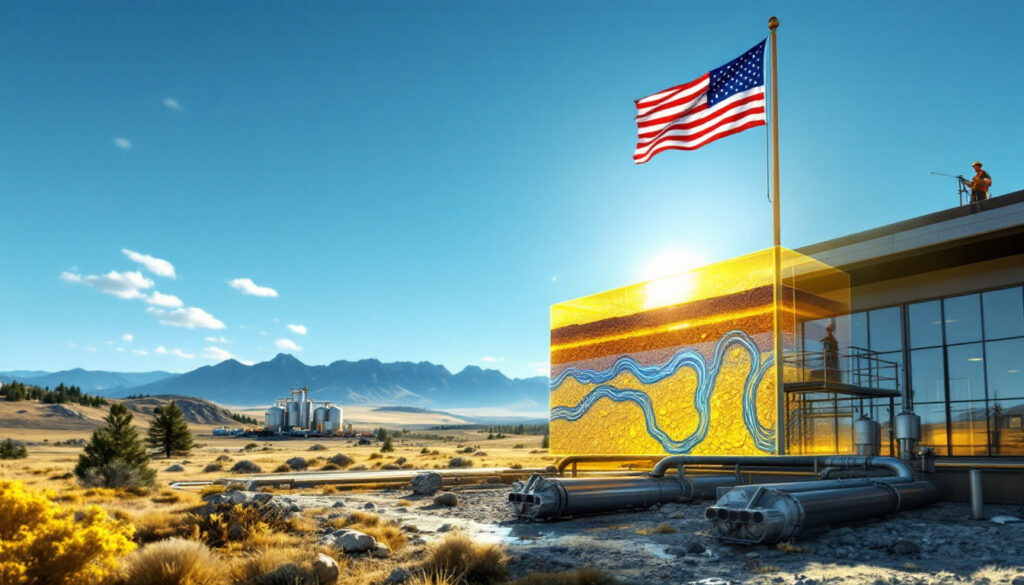How is Uranium Produced in the United States?
The ISR Mining Method
In-situ recovery (ISR) dominates U.S. uranium production, accounting for nearly all domestic output. This method involves injecting a leaching solution (typically oxygenated groundwater or carbonated water) into uranium-bearing aquifers through injection wells. The solution dissolves uranium ore underground, and the uranium-rich fluid is pumped to the surface for processing.
ISR eliminates the need for open-pit or underground mining, reducing surface disturbance and waste generation.
Lost Creek, operated by UR Energy, has utilized ISR since 2013, achieving recovery rates exceeding 90% in optimal conditions. The method requires specific geological conditions: permeable sandstone host rocks and confined aquifers to prevent solution migration. Capital costs for ISR are approximately 30–50% lower than conventional mining, but operational costs depend on uranium concentration and flow rates.
Current Production Facilities
The U.S. currently has two primary ISR facilities:
-
Lost Creek (Wyoming): Operational since 2013, with a licensed capacity of 2.2 million pounds annually. Production halted temporarily in 2018 due to low uranium prices but resumed in 2023.
-
Shirley Basin (Wyoming): Under development by UR Energy, with construction slated for completion in late 2024. The facility will share processing infrastructure with Lost Creek, reducing capital expenditures.
Combined, these sites aim to produce 1.2 million pounds by 2025, addressing a fraction of the 40–50 million pounds annual U.S. demand.
What is the Current State of US Uranium Production?
Production Volumes and Challenges
U.S. uranium production reached 400,000 pounds in 2024, a 60% increase from 2023 but still below 1% of global output. UR Energy's Lost Creek facility operates at 45–50% capacity due to workforce and technical constraints. CEO John Cash noted, "We've had our struggles with ramping up production… Workforce inexperience and equipment maintenance have been critical bottlenecks".
Production costs average $45–50 per pound, driven by fixed expenses like regulatory compliance ($5–7 million annually) and labor. By comparison, Kazakhstan's state-owned KazAtomProm produces uranium at $15–20 per pound, underscoring the U.S. industry's competitive challenges.
Economic Factors Affecting Production
U.S. producers face structural cost disadvantages:
-
Fixed Costs: Regulatory compliance, insurance, and land holdings consume 30–40% of operational budgets, irrespective of output.
-
Labor Costs: Skilled technicians earn $80,000–$120,000 annually, 20% higher than global averages.
-
Scalability: ISR economies of scale are achievable only at sustained production levels above 1 million pounds annually.
UR Energy's 2024 financials reflect these pressures, with a net loss of $6.19 per pound due to low production volumes and high purchased uranium costs.
Workforce and Operational Challenges
The uranium industry faces significant workforce challenges, with skilled labor shortages affecting operational efficiency. Training programs require 6-12 months to develop proficient operators, and retention remains difficult in competitive mining regions.
Flow rates and recovery percentages serve as critical performance indicators, with experienced teams achieving 15-20% higher recovery rates than newer personnel. Equipment maintenance, particularly at processing facilities, requires specialized knowledge that has diminished during production hiatuses.
As industry experts note, "It's never been a shortage of drill rigs. It's always been a shortage of people to operate the drill rigs."
How Do Market Dynamics Impact US Uranium Producers?
Spot Market vs. Long-Term Contracts
U.S. producers avoid the volatile spot market (current price: $60–65/lb) in favor of long-term contracts ($80/lb with inflation escalators). UR Energy has secured contracts for 5.84 million pounds through 2027, ensuring stable cash flow despite market fluctuations. Utilities prefer these contracts for price certainty; 85% of U.S. reactor requirements are met via multi-year agreements.
"Producers, legitimate producers, they sell into the term market. They don't focus on the spot. The spot market is incredibly thinly traded, especially over the last few months, and utilities spend most of their money buying in the term market," explains John Cash, CEO of UR Energy.
Contract Structures and Pricing Mechanisms
Contracts typically include:
-
Base Prices: $70–80/lb, adjusted annually for inflation (2–3% escalators).
-
Floor/Ceiling Clauses: Price floors at $60/lb and ceilings at $120/lb to mitigate volatility.
-
Delivery Flexibility: Allowances for volume adjustments (±10%) to accommodate production swings.
In 2024, UR Energy delayed 15% of contracted deliveries to 2026, citing operational delays at Shirley Basin.
Impact of Geopolitical Factors
Geopolitical uranium dynamics have increasingly influenced the market, with potential tariffs on uranium imports possibly benefiting domestic producers. The ongoing Section 232 investigation for critical minerals (including uranium) must be completed by October 2024, creating uncertainty in the market.
Previous Section 232 investigations led to the development of a uranium reserve program, demonstrating the government's willingness to support domestic production. Many utilities have delayed contracting decisions until regulatory clarity emerges, creating a backlog of demand that could accelerate once policy directions are established.
What Does the Future Hold for US Uranium Production?
Expansion Plans and New Projects
UR Energy aims to bring Shirley Basin online by early 2025, targeting 500,000–700,000 pounds annually. The site's flow rates (30–40 gallons per minute) exceed Lost Creek's by 20%, potentially lowering costs to $40–45/lb. Nineteen drill rigs at Lost Creek and six at Shirley Basin will expand wellfield capacity by 40% in 2025.
Construction at Shirley Basin includes refurbished buildings, roads, power infrastructure, and extensive monitor wells to ensure environmental compliance. Wyoming regulators will conduct pre-operational inspections before production commences, representing the final regulatory hurdle before uranium extraction can begin.
Production Forecasts and Targets
Combined production capacity between Lost Creek and Shirley Basin is expected to meet 2025 delivery commitments of 1.2 million pounds. Initial flow rates at Shirley Basin show promising results, indicating potential for exceeding production targets if operational efficiency continues to improve.
The Lost Creek processing facility has been prepared to receive and process material from Shirley Basin, with uranium-loaded resin transported between facilities for final processing. This shared infrastructure approach reduces capital expenditure while maximizing processing efficiency.
Industry Outlook and Price Projections
The global uranium market faces a 20–30 million pound annual deficit through 2030, driven by reactor restarts in Japan and new builds in China. Analysts project long-term prices of $90–100/lb to incentivize sustainable production. UR Energy's CEO cautions, "Many announced projects will fail to materialize… Higher prices are essential for marginal deposits".
Industry experts consistently note that prices need to move substantially higher to incentivize significant new production. Current 2024 uranium market trends indicate that prices of $80 may need to increase by $10-20 to stimulate major new supply sources, particularly as many announced projects face considerable technical and financial challenges before reaching production.
What Government Policies Affect US Uranium Production?
Section 232 Investigation
The April 2024 Executive Order initiated a Section 232 investigation into uranium imports, with findings due by October 2024. Potential remedies include import quotas (25–30% of utility demand) or subsidies for domestic producers. Previous 232 actions in 2019–2020 established the Uranium Reserve Program, which purchased 1.5 million pounds from UR Energy at $50–55/lb.
The Department of Commerce has 180 days to complete this investigation, after which the White House will have 90 days to determine appropriate action. Potential remedies could include trade measures or regulatory policy changes designed to strengthen domestic uranium production capability.
Uranium Reserve Program
Government initiatives have included establishing a uranium reserve to support domestic production during challenging market conditions. Under this program, UR Energy sold uranium directly to the Department of Energy, providing critical revenue during periods of market uncertainty.
Such programs help maintain domestic production capability, ensuring a strategic resource remains available during geopolitical disruptions. The future of government support measures remains uncertain pending the results of the uranium export ban analysis, but historical precedent suggests continued policy interest in maintaining domestic uranium supply chains.
Regulatory Framework
The nuclear industry operates under comprehensive regulatory oversight, with pre-operational inspections required by state authorities before new facilities can commence production. Compliance with environmental and safety regulations adds significantly to production costs, representing a substantial portion of operational expenses.
Permitting processes can extend development timelines by several years, affecting investor confidence and project economics. Regulatory stability remains essential for long-term uranium investment opportunities, with policy uncertainty cited by industry leaders as a significant impediment to capital formation in the sector.
FAQ About US Uranium Production
How does US uranium production compare to global production?
U.S. produces <1% of global uranium, vs. Kazakhstan (40%), Canada (15%), and Australia (10%). Historically, the United States was the world's leading producer, but domestic output has declined dramatically since the 1980s as lower-cost international sources captured market share. Today's U.S. production meets less than 5% of domestic reactor requirements, according to EIA uranium production data.
What are the main challenges facing US uranium producers?
Key issues include labor shortages (20% vacancy rates), regulatory delays (12–18 months for permits), and competition from state-subsidized foreign producers. Operational challenges involving ramping up production after periods of inactivity have proven particularly difficult, with workforce inexperience and equipment rehabilitation requiring significant time and investment.
How do uranium contracts typically work?
Uranium contracts between producers and utilities typically span multiple years with base pricing and inflation escalation clauses. Most contracts include market-related pricing components with floors and ceilings to protect both parties from extreme price movements while providing necessary stability for long-term planning.
How do tariffs affect producers?
Proposed 25–30% tariffs on imported uranium would minimally impact U.S. producers like UR Energy, which sells 90% domestically. However, tariffs could indirectly benefit domestic producers by increasing overall market prices and potentially incentivizing utilities to seek long-term domestic supply arrangements to mitigate future policy risks.
What are critical KPIs?
Metrics include flow rates (gallons/minute), recovery rates (>90%), header house utilization (80–90%), and downtime (<5%). Additional performance indicators include total pounds produced, processing plant efficiency, and labor productivity metrics. These key performance indicators help operators optimize production efficiency and identify operational bottlenecks requiring remediation. The uranium mining market analysis provides further insights into industry benchmarks for these critical metrics.
Ready to Capitalise on the Next Uranium Discovery?
Stay ahead of market-moving uranium developments with Discovery Alert's proprietary Discovery IQ model, which instantly notifies investors of significant ASX mineral discoveries across all commodities, including uranium. Explore historic examples of exceptional investment returns on our dedicated discoveries page and position yourself for the next major opportunity.




